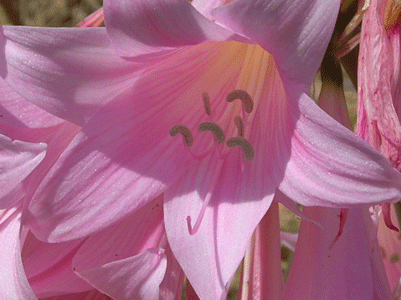Home > Education > Plant Profiles > Featured Favorites: Summer Bulbs
William's Featured Plants - Summer Bulbs - Extra Info

Bulbous plants of summer can add color, structure, interest, and wow-factor to the summer garden. Many of them are sub-tropical and thrive in the heat. Pest resistance, drought tolerance, and easy winter storage are other attributes. And, fortunately for the gardener, more varieties are becoming readily available.
This is not an all encompassing list, but a brief overview. Favorites, like lilies, daylilies, and alliums, are excluded from this list for two reasons. One, they are familiar to even novice gardeners. And two, the genera are too extensive and varied for this overview.
The amaryllis and arum families are prominently featured. Check out Amaryllidaceae and Araceae flower structures.
Some of the tender bulbs have effective flowers and/or foliage all summer. These are suited for colorful beds and borders, edging, cut flower gardens, and/or specimens. (Charts use scientific names to avoid confusion.)
All Summer Performers |
Interest |
Color |
|
|
|
Amorphophallus |
Mottled, pedate foliage |
Green, grayish, tan |
Caladium |
Heart-shaped leaves |
White, green, red patterned |
Canna |
Flowers and large, sometimes patterned leaves |
Red, yellow, etc. |
Colocasia |
Large, heart-shaped leaves |
Green, burgundy, patterned |
Dahlia |
Large aster-like flowers |
Various |
Scadoxus |
Pincushion flower, decorative leaves |
Red flowers, mottled stem |
Zephyranthes |
Cup shaped flowers |
White, yellow, pink |
Other tender bulbs shine for only a couple weeks and are better suited for natural areas, woodland gardens, water gardens, and/or containers. Treat them as garden accents.
Mid Summer |
Interest |
Color |
|
|
|
Crinum |
Large, fragrant flowers |
White, red |
Gladiolus |
Large, flower spikes |
Various |
Ornithogalum (tender) |
Large, flower spikes |
White, orange |
Zantedeschia |
Spathe and spadix, decorative leaves |
Various |
Late Summer |
Interest |
Color |
|
|
|
Amaryllis |
Naked flower stalk |
Pink, white |
Eucomis |
Flower spike, pleated leaves |
White, cream, pinkish |
Lycoris (tender) |
Naked flower stalk |
Various |
The tender bulbs should generally be removed from the garden before a hard frost and stored in a cool, dark, dry area. Basements, attached garages, stairwells, and root cellars work best. The temperature should remain above freezing. Check monthly during winter for signs of disease, rot, dessication, or premature growth.
Some gardeners treat summer bulbs as annuals. They do not dig them, but let them perish in the cold and replace them the next season. This is only acceptable for Caladium , Gladiolus , and maybe Canna . The others will grow larger, more floriferous, and more vigorous with each growing season, and should be treated as seasonal perennials.
The majority of these bulbs are tender plants that cannot withstand a Chicago winter. However, some of the best summer bulbs are hardy , and should be included in the garden's design from the start.
These hardy plants simply need conditions that approximate their original habitats. Most will do fine in a really well drained Chicago garden. The exceptions are Dichelostemma and its relative , Calochortus , which originate in the American West. Those two want to be dry during winter. Growing them may require special placement or container culture.
Whether hardy or tender, summer bulbs help fill in the gaps and keep the garden exciting through the hot summer months.
|